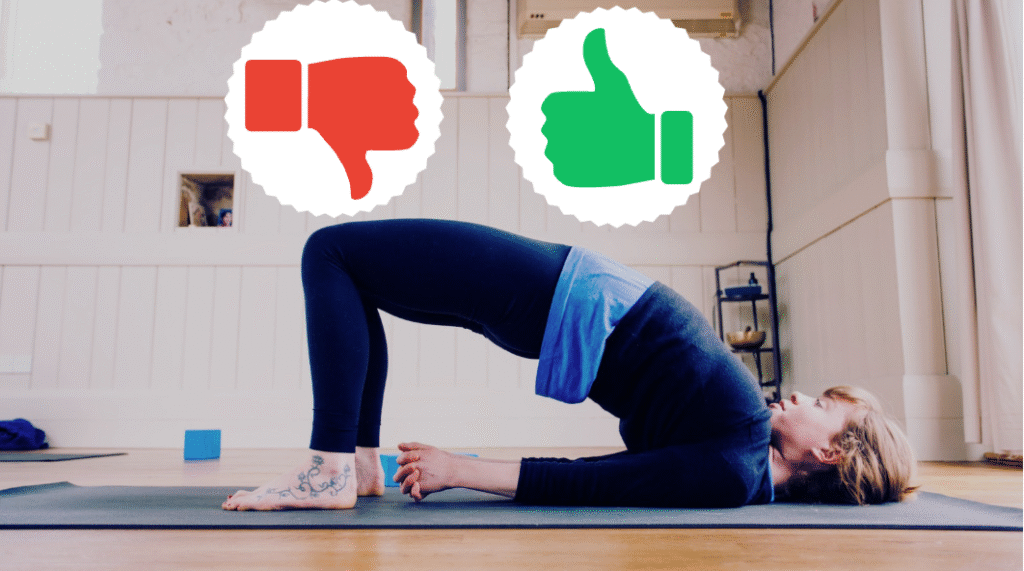Who doesn’t love an “enemies to lovers” story?
(Photo: Laura Harold | Canva | Getty)
Published September 11, 2025 07:29AM
A year ago, if you’d have asked me what I thought of Bridge Pose, I would’ve said, “Ugh, you mean that thing I pretend to do in class while I really just lie on my back and wait for Savasana?”
Because let’s be honest, Bridge Pose is an easy posture to hate.
It’s basically a false promise of relaxation. The only time I have ever practiced—well, fake practiced—Bridge was during class at my yoga studio. In the final minutes, the teacher would cue us to lie on our backs and I’d feel a flutter of excitement, assuming I’d soon be relaxing in Happy Baby or Reclined Twist—only to find out that I had to assert actual physical effort.
Pressing my feet into the mat, I’d slowly raise my hips into the air as high as I could. The thoughts running through my mind were always either frustration (“When will the teacher cue us out of this?!”) or defeat (“My hips used to lift sooo much higher. Am I too old for this?”). No amount of squeezing my lower back, glutes, and hamstrings would support my body for longer than a few seconds, so I’d collapse flat onto the mat, stare at the ceiling, and bask in my perceived failure.
It wasn’t until I took a break from yoga class—and dealt with a new source of physical discomfort—that my feelings shifted.
I’ve known for a while that sitting for prolonged periods of time tenses the hip flexors. But there came a point when I had to learn it from experience. When I’d stand up from my desk, I could feel my hip muscles pulling tight under my skin. When I’d take a walk after work, my strides were shorter, restricted by the tension in my hips, and afterward, I’d feel the muscles along my upper thighs pulsate.
After several weeks of this, I rolled out my yoga mat at home. When I’m in muscle pain or discomfort, I tend to avoid any instruction from an outside source, whether a studio yoga class or YouTube video. Instead, I move intuitively. Sometimes that looks like lying on the floor in Legs up the Chair. On this particular day, it involved lying on my back with my knees bent and feet on the floor. I could feel the muscles I wanted to stretch. I just didn’t know how to get to them, exactly.
I experimented with various movements, rocking side to side and tilting my pelvis forward and back. I realized that pressing my feet into the mat helped me do this more effortlessly. Soon I felt comfortable lifting my hips off the mat ever so slightly, feeling the satisfying stretch in my hip muscles that I’d been needing.
From the floor, I turned my head to the side and caught a glimpse of myself in the mirror. My hips were lifted, albeit low to the floor, my arms were tense, not straight and at my sides, and my gaze definitely should’ve been toward the ceiling rather than my reflection. No matter how I was doing it, it hit me that I was in Bridge Pose. And it felt freaking fantastic.
Since then, I’ve become a dedicated Bridge Pose fan, practicing on my bedroom floor before I go to sleep, on my towel at the beach, even on a massage table after a 50-minute session. There was something about taking away the pressure of what I thought Bridge should look like that let me find my way to it on my own. Without a teacher, cues, or anyone else to compare myself to, I could finally understand that not everyone’s Bridge Pose will look the same—not even my own Bridge Pose from year to year or moment to moment. By focusing on how it feels, I removed the obstacles that were keeping me from a pretty kickass stretch.
The more I think about it, the more life lessons I recognize in this experience. That it doesn’t matter how something looks as much as how it feels. That I don’t need to judge something—or myself—based on my false expectations. And that I can trust myself and intuit my way forward.


